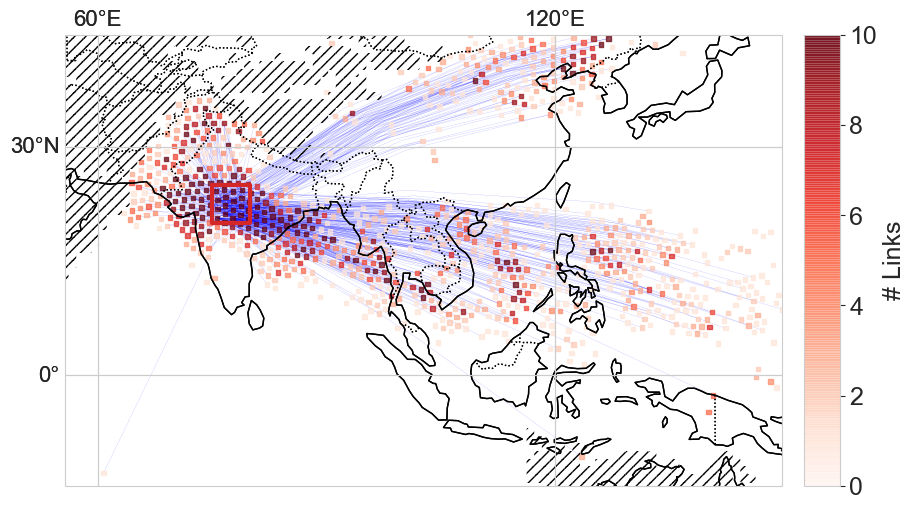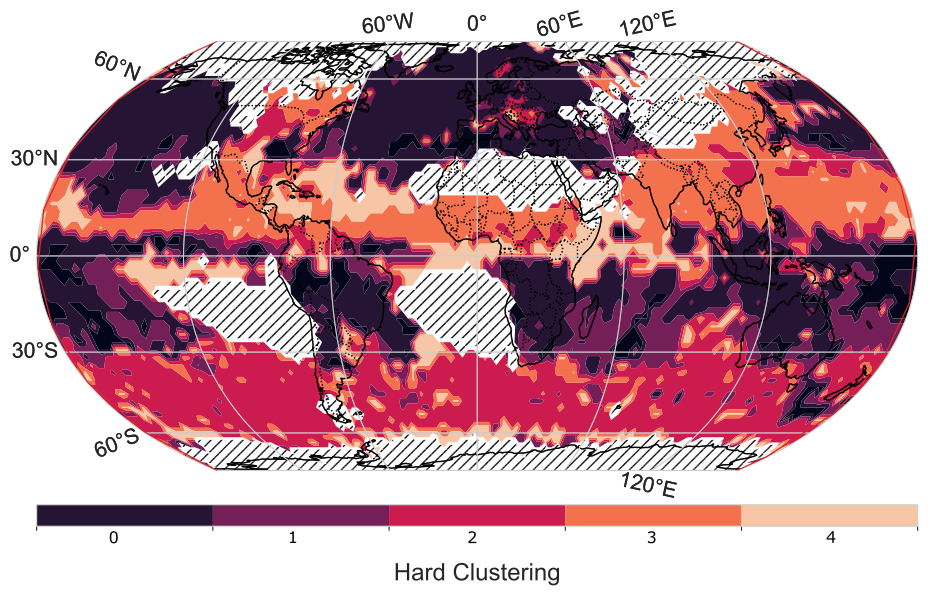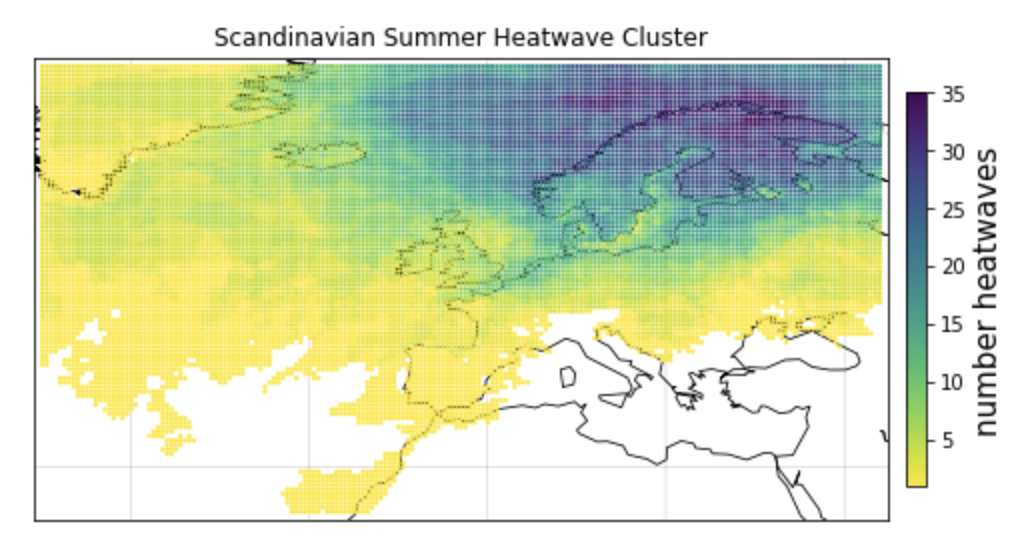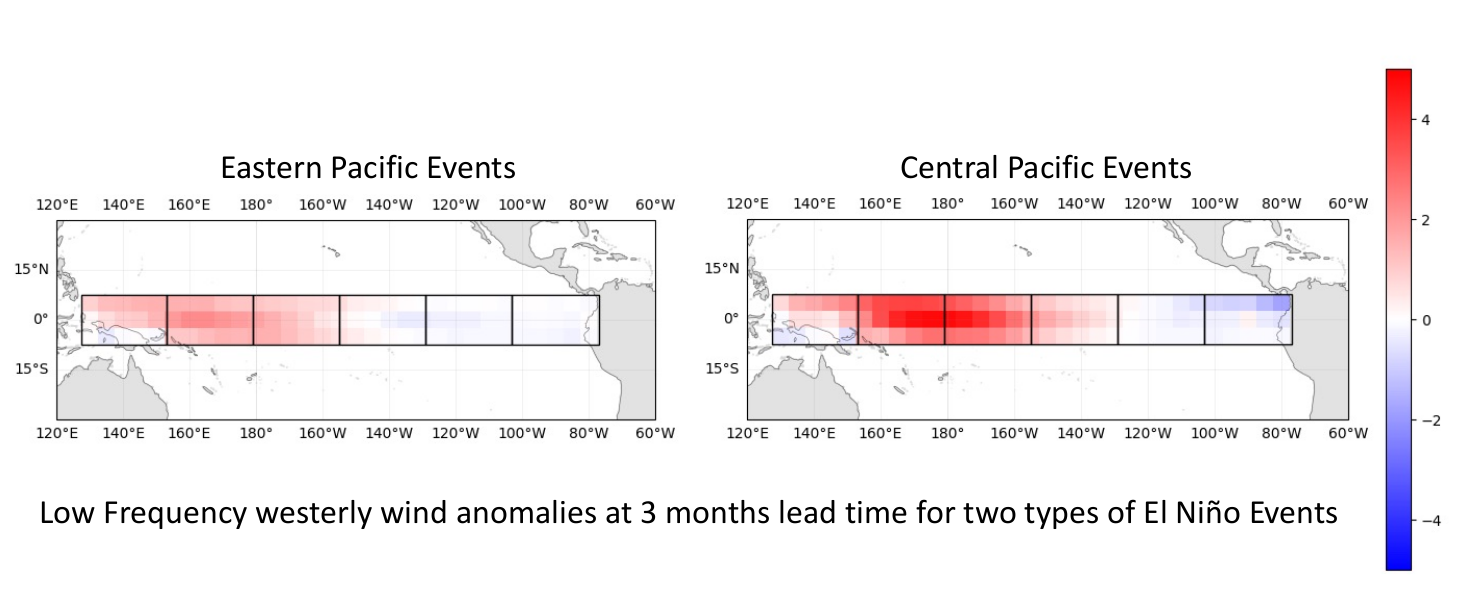
We currently have two doctoral projects and a third one that will start in Fall of 2021. Additionally, we have a couple of undergrad projects and a third one set to start in spring. Below we provide brief summaries of these projects going on the group.
Doctoral Projects
Masters projects
Bachelors projects
Doctoral projects
Predicting Sea Surface Temperature Patterns in the Pacific Ocean
Jakob Schlör
The most dominant mode of oceanic climate variability on an interdecadel scale is the El Niño Southern Oscillation (ENSO). ENSO events are characterized by the anomalous sea surface temperatures (SSTs) in the equatorial Pacific. Large anomalies in this region are known to have high impact on global climate, as for instance, intense rainfall over Peru and droughts and wildfires in Northern Australia during the ENSO warm phase, known as El Niño. Although ENSO is an important climate phenomena, its cause and variability is not yet fully understood, which makes it hard for climate models to capture and predict its occurrence. In this project, we aim to forecast the equatorial SST anomaly patterns in the Pacific based on a data driven approach used together with probabilistic generative models (PGMs). PGMs allow us to make spatial and temporal predictions with uncertainties as well as reveal insights into underlying drivers of the modeled phenomenon. Our final goal is to be able to provide local SST forecasts from a global perspective.

Analyzing the Monsoon Dynamics by Complex Networks
Felix Strnad
Analyzing rainfall events reveals areas on every continent that reveal similar behaviour: Heavy rainfalls during metereological summer and drier conditions during metereological winter. These areas are labelled as monsoon systems. In the last years, the phenomena has emerged as the concept of the Global Monsoon (GM), a global-scale solstitial mode that drives the annual variation of tropical and subtropical precipitation. However, its underlying dynamical behavior and interconnections to other global scale weather systems is so far not fully understood. We want to investigate the dynamics of the GM via methods from complex network analysis and Bayesian Inference. By better understanding the common/different variabilities in monsoon dynamics we hope to provide reliable estimates of the consequences of global climate change to the monsoon system. Complex Climate Networks of extreme rainfall events can tell us a lot about synchronization of rainfall events over long-range spatial distances. We use it to better understand the physical mechanisms behind these long-range spatial teleconnections.

Seasonal weather forecasts using deep learning
Jannik Thümmel
Atmospheric processes are highly non-linear and chaotic rendering long-term forecasts of their dynamics impossible. However, there exist recurring patterns in the climate system that lead to predictable tendencies in weather. These patterns are termed teleconnections for their effects on distant regions of the planet. Well-known examples include the El-Nino-Southern-Oscillation, the Northern-Atlantic-Oscillation and the Madden-Julian-Oscillation, which occur on annual (ENSO), seasonal (NAO) and sub-seasonal (MJO) temporal scales. Teleconnections are known to be a significant driver of weather patterns and could be exploited to generate predictions of weather trends far beyond the forecast horizon of atmospheric models. Machine Learning is ideally suited to identify subtle patterns in complex data and exploit these patterns to generate predictions. Therefore the aim of our project is to develop machine learning systems that are able to identify teleconnection patterns from data and generate skillful predictions at time scales that are difficult to model with numerical methods. We are looking to design neural network architectures that incorporate physical knowledge as inductive biases and that are capable of modeling the effects of teleconnections across large spatial and temporal scales.
Pitfalls and possible improvements in climate networok construction
Moritz Haas

Empirical distributions of node-wise network characteristics using Pearson correlation (common for climate networks) for data generated from a Matern isotropic Gaussian random field. Dotted lines denote the ground truth distributions. In the regime of scarce data (in time), the empirical networks have systematically distorted characteristics compared to the ground truth, where the shortest links are formed.
Masters Projects
Explainable community structure in climate networks
Merle Kammer
Climate networks have helped to uncover complex structures in climatic observables. For instance, climate networks were used to reduce rainfall data to relevant patterns that can be linked to geophysical processes. However, the identification of regions that show similar behavior with respect to the timing and spatial distribution of extreme rainfall events (EREs) remains challenging. We want to apply a recently developed algorithmic framework based on tangles to discover community structures in the spatial distribution of EREs. Tangles enables us to create a hierarchical tree representation of communities including the likelihood that spatial locations belong to a community. Each tree layer can be associated to a closed question, thus making the division of different communities transparent. Applied to global precipitation data, we hope that tangles is a promising tool to quantify community structures and to reveal underlying geophysical processes leading to these structures.

Parameter inference and uncertainty quantification for an intermediate complexity climate model
Benedict Roeder (Master’s Thesis)
Well-adapted parameters in climate models are essential to make accurate predictions for future projections. In climate science, the record of precise and comprehensive observational data is rather short and parameters of climate models are often hand-tuned or learned from artificially generated data. Due to limited and noisy data, one wants to use Bayesian models to have access to uncertainties of the inferred parameters. Most popular algorithms for learning parameters from observational data like the Kalman inversion approach only provide point estimates of parameters. In this work, we compare two Bayesian parameter inference approaches applied to the intermediate complexity model for the El Niño-Southern Oscillation by Zebiak & Cane. i) The “Calibrate, Emulate, Sample” (CES) approach, an extension of the ensemble Kalman inversion which allows posterior inference by emulating the model via Gaussian Processes and thereby enables efficient sampling. ii) The simulation-based inference (SBI) approach where the approximate posterior distribution is learned from simulated model data and observational data using neural networks. We evaluate the performance of both approaches by comparing their run times and the number of required model evaluations, assess the scalability with respect to the number of inference parameters, and examine their posterior distributions.

Spatiotemporal patterns of European heatwaves and their influence on vegetation
Julia Hellmig
Heatwaves are extreme events that have the potential to cause deaths, agricultural loss and damage ecosystems. With anthropogenic climate change, heatwaves have been shown to occur more often already and are suspected to become even more frequent in the future. Especially Europe is a heatwave epicenter, with mega-heatwaves in 2003, 2010 and 2018 just to name a few. This project aims to analyze spatio-temporal patterns of European heatwaves with the graphs framework Deep Graphs. We try to cluster Euopean heatwaves spatially and temporally, in order to find distinct heatwave families. We suggest that heatwaves within one family might be caused by the same atmospheric regime. In the long run this approach could be a first step to better predict heatwave in the future. A second part of the project analyzes the influence of heatwave families and individual heatwaves on vegetation. We expect to see differences in the influence of extreme heat on vegetation at different locations in Europe.

Spatiotemporal analysis of extreme rainfall clusters over North Indian Ocean
Ranganatha B R
The project aims at studying tropical cyclones and their tracks using precipitation data. The statistical analysis of the storm tracks constructed using Deepgraphs allows us to differentiate between different physical phenomena which are different over land and ocean. Further, the tracks exhibit a pattern that can be studied using Machine Learning which can help us be well prepared for future heavy precipitation events like tropical cyclones and depressions. Since Long Short Term Memory (LSTM) is a special kind of Recurrent Neural Network that can learn sequence data much more efficiently than other deep learning methods, we use them to predict future track. We use different models with varying inputs to efficiently predict the storm track. Successful training of these models validates the existence of a storm track pattern in the North Indian Ocean along with the proof of the concept that tropical cyclones can be studied under the banner of extreme precipitation.

Bachelors Projects
Spatial and frequency dependence of westerly wind events causing ENSO diversity
Jakob Unterholzner
The El Nino Southern Oscillation (ENSO) shows different characteristics regarding the location of its highest Sea Surface Temperature anomalies, ranging from Eastern Pacific (EP) to Central Pacific (CP) events. Both types of ENSO events inhabit different teleconnections and impacts around the world. While stochastic wind forcing is one of the known drivers of the ENSO, the influence of westerly wind anomalies over the equatorial pacific on ENSO development, regarding its diversity remain unclear. We conduct a spectral analysis of daily wind data, yielding high and low frequency components of wind anomalies for different equatorial pacific regions. As a starting point we investigate their respective influence on ENSO diversity by means of multiple linear regression models. Following we use causal network discovery with PCMCI algorithm to infer the important westerly wind events that drive ENSO diversity. These result are used for ENSO prediction with multiple layer perceptrons, to demonstrate that specific regions at specific lead times are most important for either EP or CP events. This study might help climate models in their prediction ability of ENSO diversity by including relevant wind information and thereby improve forecasting of ENSO and its implications.

Machine Learning Methods to Model Monthly Precipitation over Southern Europe Using Climate Indices
Davide Lussu (Bachelor’s Thesis)
The Mediterranean region is one of the regions most strongly affected by climate change. A decline in precipitation is observed in the region with consequences for agriculture and water resources. Various atmospheric modes such as the North Atlantic Oscillation impact the precipitation in this region. Indices measuring the pressure difference between two locations to describe these oscillating modes can be correlated to the precipitation. This project explores different statistical machine learning methods to describe precipitation based on the Oscillation Indices. Regression is performed on timeseries of all indices to model precipitation provided by the ERA5 monthly precipitation dataset spanning over the past 40 years. The methods used are basic Linear Regression, a Random Forest Regressor and an Artificial Neural Network (ANN) which are fitted to the time series on each location on the map. Also a further ANN approach is tested that uses all time series with added coordinates as an input for training

Impact of strong El Niño events on river discharge in South America
Markus Deppner (Bachelor’s Thesis)
The El Niño Southern Oscillation (ENSO) is one of the most influential climate patterns in terms of climate variability around the globe and yet all its impacts are not fully understood. This project investigates the magnitude of El Niño (EN) events on river discharge in South America as EN-related floods can cause ecological, economical and social problems in many regions around the continent. By applying machine learning techniques on the “Global Streamflow Indices and Metadata archive” (GSIM) we plan to extend the amount of in situ stations for a 40 year timespan by almost three-fold. The idea is to infer missing streamflow data by using the temporal correlations of stations with missing values to others with data. This approach provides a possible solution for the problems of scattered data and in situ stations temporarily fading in and out, which makes large-scale hydrological research challenging.
